This section presents a simple language for drawing
pictures that illustrates the
power of data abstraction and closure,
and also exploits higher-order procedures in
an essential way. The language
is designed to make it easy to experiment with patterns
such as the ones in figure ![[*]](../image/cross_ref_motif.gif) , which are
composed of repeated elements that are shifted and scaled.
, which are
composed of repeated elements that are shifted and scaled.
![[*]](../image/foot_motif.gif) In this language,
the data objects being combined
are represented as procedures rather than as list structure.
Just as cons, which satisfies the
closure property,
allowed us to easily build arbitrarily complicated
list structure, the operations in this language, which also
satisfy the closure property, allow us to easily build
arbitrarily complicated patterns.
In this language,
the data objects being combined
are represented as procedures rather than as list structure.
Just as cons, which satisfies the
closure property,
allowed us to easily build arbitrarily complicated
list structure, the operations in this language, which also
satisfy the closure property, allow us to easily build
arbitrarily complicated patterns.
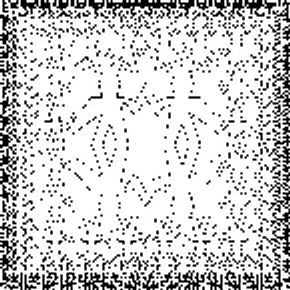
The picture language
When we began our study of programming in
section ![[*]](../image/cross_ref_motif.gif) , we emphasized the
importance of describing a language by focusing on the language's
primitives, its means of combination, and its means of abstraction.
We'll follow that framework here.
, we emphasized the
importance of describing a language by focusing on the language's
primitives, its means of combination, and its means of abstraction.
We'll follow that framework here.
Part of the elegance of this picture language is that there is
only one kind of element, called a
painter. A painter
draws an image that is shifted and scaled to fit within a designated
parallelogram-shaped frame. For example, there's a primitive painter
we'll call wave that makes a crude line drawing, as
shown in figure ![[*]](../image/cross_ref_motif.gif) .
The actual shape of the drawing depends on the frame--all
four images in figure
.
The actual shape of the drawing depends on the frame--all
four images in figure ![[*]](../image/cross_ref_motif.gif) are produced by the same
wave painter, but with respect to four different frames. Painters
can be more elaborate than this:
The primitive
painter called rogers paints a picture of MIT's founder,
William Barton Rogers, as shown in figure
are produced by the same
wave painter, but with respect to four different frames. Painters
can be more elaborate than this:
The primitive
painter called rogers paints a picture of MIT's founder,
William Barton Rogers, as shown in figure ![[*]](../image/cross_ref_motif.gif) .
.
![[*]](../image/foot_motif.gif) The four images in figure
The four images in figure ![[*]](../image/cross_ref_motif.gif) are drawn with respect to the same four frames
as the wave images in figure
are drawn with respect to the same four frames
as the wave images in figure ![[*]](../image/cross_ref_motif.gif) .
.
To combine images, we use various operations that construct new painters from given painters. For example, the beside operation takes two painters and produces a new, compound painter that draws the first painter's image in the left half of the frame and the second painter's image in the right half of the frame. Similarly, below takes two painters and produces a compound painter that draws the first painter's image below the second painter's image. Some operations transform a single painter to produce a new painter. For example, flip-vert takes a painter and produces a painter that draws its image upside-down, and flip-horiz produces a painter that draws the original painter's image left-to-right reversed.
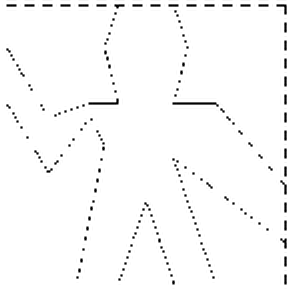
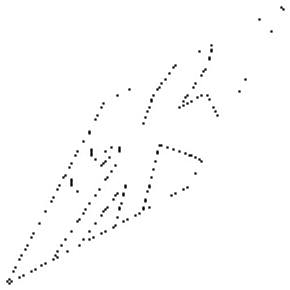
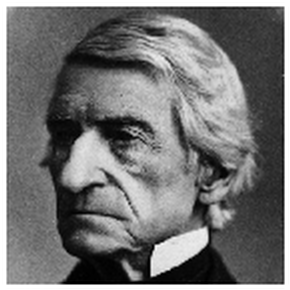
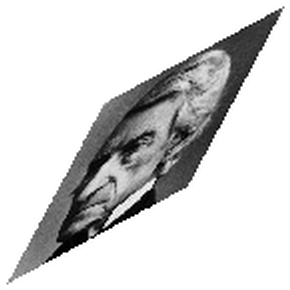
Figure ![[*]](../image/cross_ref_motif.gif) shows the drawing of a painter called
wave4 that is built up in two stages starting from wave:
shows the drawing of a painter called
wave4 that is built up in two stages starting from wave:
(define wave2 (beside wave (flip-vert wave))) (define wave4 (below wave2 wave2))
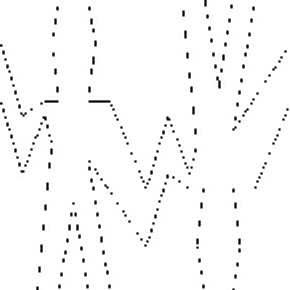
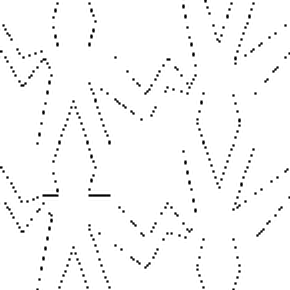
In building up a complex image in this manner we are exploiting the fact that painters are closed under the language's means of combination. The beside or below of two painters is itself a painter; therefore, we can use it as an element in making more complex painters. As with building up list structure using cons, the closure of our data under the means of combination is crucial to the ability to create complex structures while using only a few operations.
Once we can combine painters, we would like to be able to abstract typical patterns of combining painters. We will implement the painter operations as Scheme procedures. This means that we don't need a special abstraction mechanism in the picture language: Since the means of combination are ordinary Scheme procedures, we automatically have the capability to do anything with painter operations that we can do with procedures. For example, we can abstract the pattern in wave4 as
(define (flipped-pairs painter)
(let ((painter2 (beside painter (flip-vert painter))))
(below painter2 painter2)))
and define wave4 as an instance of this pattern:
(define wave4 (flipped-pairs wave))
We can also define recursive operations.
Here's one that makes painters split and branch
towards the right as shown in figures ![[*]](../image/cross_ref_motif.gif) and
and ![[*]](../image/cross_ref_motif.gif) :
:
(define (right-split painter n)
(if (= n 0)
painter
(let ((smaller (right-split painter (- n 1))))
(beside painter (below smaller smaller)))))
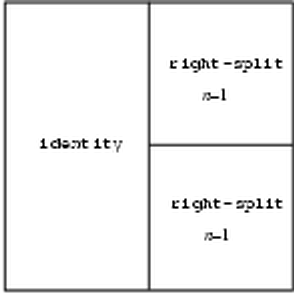
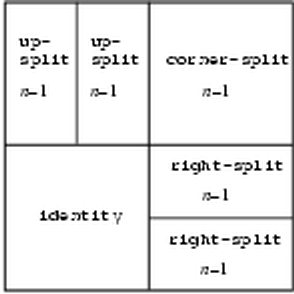
We can produce balanced patterns by branching upwards
as well as towards the right (see exercise ![[*]](../image/cross_ref_motif.gif) and figures
and figures ![[*]](../image/cross_ref_motif.gif) and
and ![[*]](../image/cross_ref_motif.gif) ):
):
(define (corner-split painter n)
(if (= n 0)
painter
(let ((up (up-split painter (- n 1)))
(right (right-split painter (- n 1))))
(let ((top-left (beside up up))
(bottom-right (below right right))
(corner (corner-split painter (- n 1))))
(beside (below painter top-left)
(below bottom-right corner))))))
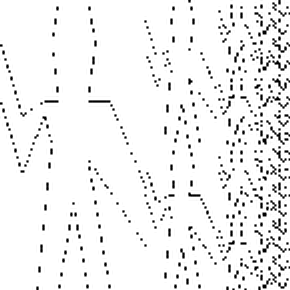

By placing four copies of a corner-split
appropriately, we obtain a pattern called square-limit, whose
application to wave and rogers is shown in
figure ![[*]](../image/cross_ref_motif.gif) :
:
(define (square-limit painter n)
(let ((quarter (corner-split painter n)))
(let ((half (beside (flip-horiz quarter) quarter)))
(below (flip-vert half) half))))
Exercise. Define the procedure up-split used by corner-split. It is similar to rightsplit, except that it switches the roles of below and beside.
Higher-order operations
In addition to abstracting patterns of combining painters, we can work at a higher level, abstracting patterns of combining painter operations. That is, we can view the painter operations as elements to manipulate and can write means of combination for these elements--procedures that take painter operations as arguments and create new painter operations.
For example, flipped-pairs and square-limit each arrange four copies of a painter's image in a square pattern; they differ only in how they orient the copies. One way to abstract this pattern of painter combination is with the following procedure, which takes four one-argument painter operations and produces a painter operation that transforms a given painter with those four operations and arranges the results in a square. Tl, tr, bl, and br are the transformations to apply to the top left copy, the top right copy, the bottom left copy, and the bottom right copy, respectively.
(define (square-of-four tl tr bl br)
(lambda (painter)
(let ((top (beside (tl painter) (tr painter)))
(bottom (beside (bl painter) (br painter))))
(below bottom top))))
Then flipped-pairs can be defined in terms
of square-of-four as follows:![[*]](../image/foot_motif.gif)
(define (flipped-pairs painter)
(let ((combine4 (square-of-four identity flip-vert
identity flip-vert)))
(combine4 painter)))
and square-limit can be expressed as![[*]](../image/foot_motif.gif)
(define (square-limit painter n)
(let ((combine4 (square-of-four flip-horiz identity
rotate180 flip-vert)))
(combine4 (corner-split painter n))))
Exercise. Right-split and up-split can be expressed as instances of a general splitting operation. Define a procedure split with the property that evaluating
(define right-split (split beside below)) (define up-split (split below beside))produces procedures right-split and up-split with the same behaviors as the ones already defined.
Frames
Before we can show how to implement painters and their means of combination, we must first consider frames. A frame can be described by three vectors--an origin vector and two edge vectors. The origin vector specifies the offset of the frame's origin from some absolute origin in the plane, and the edge vectors specify the offsets of the frame's corners from its origin. If the edges are perpendicular, the frame will be rectangular. Otherwise the frame will be a more general parallelogram.
Figure ![[*]](../image/cross_ref_motif.gif) shows a frame and its associated vectors. In
accordance with data abstraction, we need not be
specific yet about how frames are represented, other than to say that
there is a constructor
make-frame, which takes three vectors and
produces a frame, and three corresponding selectors
origin-frame,
edge1-frame, and
edge2-frame (see
exercise
shows a frame and its associated vectors. In
accordance with data abstraction, we need not be
specific yet about how frames are represented, other than to say that
there is a constructor
make-frame, which takes three vectors and
produces a frame, and three corresponding selectors
origin-frame,
edge1-frame, and
edge2-frame (see
exercise ![[*]](../image/cross_ref_motif.gif) ).
).
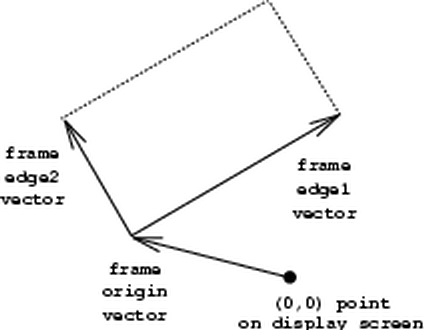
We will use coordinates in the unit square (
![]() )
to specify images.
With each frame, we associate a
frame coordinate map, which
will be used to shift and scale images to fit the frame. The map
transforms the unit square into the frame by
mapping the vector
)
to specify images.
With each frame, we associate a
frame coordinate map, which
will be used to shift and scale images to fit the frame. The map
transforms the unit square into the frame by
mapping the vector
![]() to the vector sum
to the vector sum
For example, (0,0) is mapped to the origin of the frame, (1,1) to the vertex diagonally opposite the origin, and (0.5,0.5) to the center of the frame. We can create a frame's coordinate map with the following procedure:
![[*]](../image/foot_motif.gif)
(define (frame-coord-map frame)
(lambda (v)
(add-vect
(origin-frame frame)
(add-vect (scale-vect (xcor-vect v)
(edge1-frame frame))
(scale-vect (ycor-vect v)
(edge2-frame frame))))))
Observe that applying frame-coord-map to a frame returns
a procedure that, given a vector, returns a vector.
If the argument vector is in the unit square, the result vector
will be in the frame. For example,
((frame-coord-map a-frame) (make-vect 0 0))returns the same vector as
(origin-frame a-frame)
Exercise. A two-dimensional vector v running from the origin to a point
can be represented as a pair
consisting of an x-coordinate and a y-coordinate. Implement a data
abstraction for vectors by giving a constructor
make-vect and
corresponding selectors
xcor-vect and
ycor-vect. In
terms of your selectors and constructor, implement procedures
add-vect,
sub-vect, and
scale-vect that perform
the operations vector addition, vector subtraction, and multiplying a
vector by a scalar:

Exercise. Here are two possible constructors for frames:
(define (make-frame origin edge1 edge2) (list origin edge1 edge2))For each constructor supply the appropriate selectors to produce an implementation for frames.(define (make-frame origin edge1 edge2) (cons origin (cons edge1 edge2)))
Painters
A painter is represented as a procedure that, given a frame as argument, draws a particular image shifted and scaled to fit the frame. That is to say, if p is a painter and f is a frame, then we produce p's image in f by calling p with f as argument.
The details of how primitive painters are implemented depend on the
particular characteristics of the graphics system and the type of
image to be drawn. For instance, suppose we have a procedure
draw-line that draws a line on the screen between two specified
points. Then we can create painters for line drawings, such as the
wave painter in figure ![[*]](../image/cross_ref_motif.gif) , from lists of line
segments as follows:
, from lists of line
segments as follows:
![[*]](../image/foot_motif.gif)
(define (segments->painter segment-list)
(lambda (frame)
(for-each
(lambda (segment)
(draw-line
((frame-coord-map frame) (start-segment segment))
((frame-coord-map frame) (end-segment segment))))
segment-list)))
The segments are given using coordinates with respect to the unit
square. For each segment in the list, the painter transforms the
segment endpoints with the frame coordinate map and draws a line
between the transformed points.
Representing painters as procedures erects a powerful abstraction
barrier in the picture language. We can create and intermix
all sorts of primitive painters, based on a variety of graphics
capabilities. The details of their implementation do not matter. Any
procedure can serve as a painter, provided that it takes a frame as
argument and draws something scaled to fit the frame.
![[*]](../image/foot_motif.gif)
Exercise.
A directed line segment in the
plane can be represented as a pair of vectors--the
vector running from the origin to the start-point of the segment, and
the vector running from the origin to the end-point of the segment.
Use your vector representation from exercise ![[*]](../image/cross_ref_motif.gif) to
define a representation for segments with a constructor
make-segment and selectors
start-segment and
end-segment.
to
define a representation for segments with a constructor
make-segment and selectors
start-segment and
end-segment.
Exercise. Use segments->painter to define the following primitive painters:
aThe painter that draws the outline of the designated frame.
bThe painter that draws an ``X'' by connecting opposite corners of the frame.
cThe painter that draws a diamond shape by connecting the midpoints of the sides of the frame.
Transforming and combining painters
An operation on painters (such as flip-vert or beside) works by creating a painter that invokes the original painters with respect to frames derived from the argument frame. Thus, for example, flip-vert doesn't have to know how a painter works in order to flip it--it just has to know how to turn a frame upside down: The flipped painter just uses the original painter, but in the inverted frame.
Painter operations are based on the procedure transform-painter, which takes as arguments a painter and information on how to transform a frame and produces a new painter. The transformed painter, when called on a frame, transforms the frame and calls the original painter on the transformed frame. The arguments to transform-painter are points (represented as vectors) that specify the corners of the new frame: When mapped into the frame, the first point specifies the new frame's origin and the other two specify the ends of its edge vectors. Thus, arguments within the unit square specify a frame contained within the original frame.
(define (transform-painter painter origin corner1 corner2)
(lambda (frame)
(let ((m (frame-coord-map frame)))
(let ((new-origin (m origin)))
(painter
(make-frame new-origin
(sub-vect (m corner1) new-origin)
(sub-vect (m corner2) new-origin)))))))
Here's how to flip painter images vertically:
(define (flip-vert painter)
(transform-painter painter
(make-vect 0.0 1.0) ; new origin
(make-vect 1.0 1.0) ; new end of edge1
(make-vect 0.0 0.0))) ; new end of edge2
Using transform-painter, we can easily define new transformations.
For example, we can define a painter that shrinks its image to the
upper-right quarter of the frame it is given:
(define (shrink-to-upper-right painter)
(transform-painter painter
(make-vect 0.5 0.5)
(make-vect 1.0 0.5)
(make-vect 0.5 1.0)))
Other transformations rotate images counterclockwise by 90 degrees
![[*]](../image/foot_motif.gif)
(define (rotate90 painter)
(transform-painter painter
(make-vect 1.0 0.0)
(make-vect 1.0 1.0)
(make-vect 0.0 0.0)))
or squash images towards the center of the frame:
![[*]](../image/foot_motif.gif)
(define (squash-inwards painter)
(transform-painter painter
(make-vect 0.0 0.0)
(make-vect 0.65 0.35)
(make-vect 0.35 0.65)))
Frame transformation is also the key to defining means of combining two or more painters. The beside procedure, for example, takes two painters, transforms them to paint in the left and right halves of an argument frame respectively, and produces a new, compound painter. When the compound painter is given a frame, it calls the first transformed painter to paint in the left half of the frame and calls the second transformed painter to paint in the right half of the frame:
(define (beside painter1 painter2)
(let ((split-point (make-vect 0.5 0.0)))
(let ((paint-left
(transform-painter painter1
(make-vect 0.0 0.0)
split-point
(make-vect 0.0 1.0)))
(paint-right
(transform-painter painter2
split-point
(make-vect 1.0 0.0)
(make-vect 0.5 1.0))))
(lambda (frame)
(paint-left frame)
(paint-right frame)))))
Observe how the painter data abstraction, and in particular the representation of painters as procedures, makes beside easy to implement. The beside procedure need not know anything about the details of the component painters other than that each painter will draw something in its designated frame.
Exercise. Define the transformation flip-horiz, which flips painters horizontally, and transformations that rotate painters counterclockwise by 180 degrees and 270 degrees.
Exercise.
Define the
below operation for painters. Below takes two
painters as arguments. The resulting painter, given a frame,
draws with the first painter in the
bottom of the frame and with the second painter in the top. Define
below in two different ways--first by writing a procedure that is
analogous to the beside procedure given above, and
again in terms of beside and suitable
rotation operations (from exercise ![[*]](../image/cross_ref_motif.gif) ).
).
Levels of language for robust design
The picture language exercises some of the critical ideas we've introduced about abstraction with procedures and data. The fundamental data abstractions, painters, are implemented using procedural representations, which enables the language to handle different basic drawing capabilities in a uniform way. The means of combination satisfy the closure property, which permits us to easily build up complex designs. Finally, all the tools for abstracting procedures are available to us for abstracting means of combination for painters.
We have also obtained a glimpse of another crucial idea about languages and program design. This is the approach of stratified design, the notion that a complex system should be structured as a sequence of levels that are described using a sequence of languages. Each level is constructed by combining parts that are regarded as primitive at that level, and the parts constructed at each level are used as primitives at the next level. The language used at each level of a stratified design has primitives, means of combination, and means of abstraction appropriate to that level of detail.
Stratified design pervades the engineering of complex systems. For
example, in computer engineering, resistors and transistors are
combined (and described using a language of analog circuits) to
produce parts such as and-gates and or-gates, which form the
primitives of a language for digital-circuit design.
![[*]](../image/foot_motif.gif) These parts are combined to build
processors, bus structures, and memory systems, which are in turn
combined to form computers, using languages appropriate to computer
architecture. Computers are combined to form distributed systems,
using languages appropriate for describing network interconnections,
and so on.
These parts are combined to build
processors, bus structures, and memory systems, which are in turn
combined to form computers, using languages appropriate to computer
architecture. Computers are combined to form distributed systems,
using languages appropriate for describing network interconnections,
and so on.
As a tiny example of stratification, our picture language uses primitive elements (primitive painters) that are created using a language that specifies points and lines to provide the lists of line segments for segments->painter, or the shading details for a painter like rogers. The bulk of our description of the picture language focused on combining these primitives, using geometric combiners such as beside and below. We also worked at a higher level, regarding beside and below as primitives to be manipulated in a language whose operations, such as square-of-four, capture common patterns of combining geometric combiners.
Stratified design helps make programs robust, that is, it makes
it likely that small changes in a specification will require
correspondingly small changes in the program. For instance, suppose
we wanted to change the image based on wave shown in
figure ![[*]](../image/cross_ref_motif.gif) . We could work at the lowest level
to change the detailed appearance of the wave element; we could
work at the middle level to change the way corner-split
replicates the wave; we could work at the highest level to
change how square-limit arranges the four copies of the corner.
In general, each level of a stratified design provides a different
vocabulary for expressing the characteristics of the system, and a
different kind of ability to change it.
. We could work at the lowest level
to change the detailed appearance of the wave element; we could
work at the middle level to change the way corner-split
replicates the wave; we could work at the highest level to
change how square-limit arranges the four copies of the corner.
In general, each level of a stratified design provides a different
vocabulary for expressing the characteristics of the system, and a
different kind of ability to change it.
Exercise.
Make changes to the square limit of wave shown in
figure ![[*]](../image/cross_ref_motif.gif) by working at each of the levels
described above. In particular:
by working at each of the levels
described above. In particular:
aAdd some segments to the primitive wave painter
of exercise ![[*]](../image/cross_ref_motif.gif) (to add a smile, for example).
(to add a smile, for example).
bChange the pattern constructed by corner-split (for example, by using only one copy of the up-split and right-split images instead of two).
cModify the version of square-limit that uses square-of-four so as to assemble the corners in a different pattern. (For example, you might make the big Mr. Rogers look outward from each corner of the square.)


